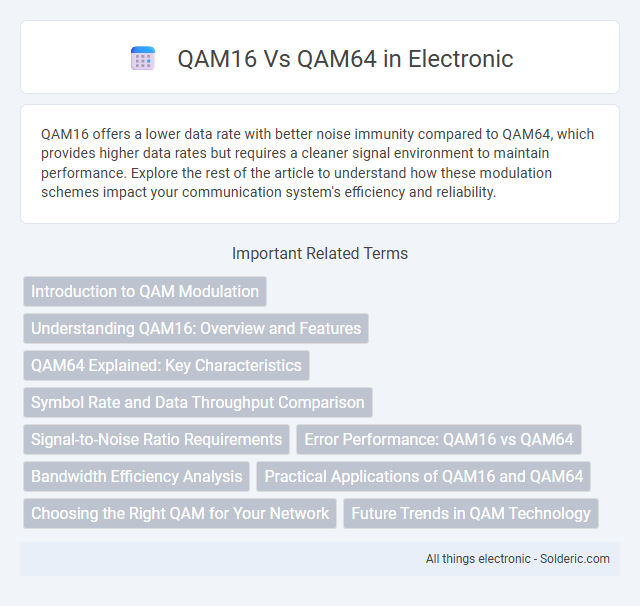QAM16 offers a lower data rate with better noise immunity compared to QAM64, which provides higher data rates but requires a cleaner signal environment to maintain performance. Explore the rest of the article to understand how these modulation schemes impact your communication system's efficiency and reliability.
Comparison Table
| Feature | QAM16 | QAM64 |
|---|---|---|
| Modulation Type | 16-level Quadrature Amplitude Modulation | 64-level Quadrature Amplitude Modulation |
| Bits per Symbol | 4 bits | 6 bits |
| Data Rate | Lower than QAM64 | Higher than QAM16 |
| Signal-to-Noise Ratio (SNR) Requirement | Lower SNR needed | Higher SNR needed for accurate decoding |
| Error Performance | More robust to noise | Less robust, prone to errors in noisy environments |
| Use Cases | Lower data rate applications, noisy channels | High data rate transmissions, clean channels |
Introduction to QAM Modulation
QAM16 and QAM64 are digital modulation schemes used in wireless communication to increase data transmission efficiency by conveying multiple bits per symbol through varying amplitude and phase. QAM16 uses 16 distinct symbol states, encoding 4 bits per symbol, while QAM64 expands this to 64 states, encoding 6 bits per symbol for higher data rates at the cost of increased susceptibility to noise and interference. These modulation techniques are integral to standards like LTE and Wi-Fi, facilitating higher throughput by balancing spectral efficiency and signal robustness.
Understanding QAM16: Overview and Features
QAM16, or 16 Quadrature Amplitude Modulation, encodes data using 16 distinct signal points, providing a balance between data rate and signal robustness. Its key features include moderate spectral efficiency and improved noise tolerance compared to higher-order schemes like QAM64, making it suitable for environments requiring reliable transmission under varying channel conditions. Understanding QAM16's signal constellation and error performance helps in optimizing wireless communication systems where moderate throughput and stability are critical.
QAM64 Explained: Key Characteristics
QAM64 utilizes 64 distinct signal points to encode six bits per symbol, offering higher data rates compared to QAM16, which encodes four bits per symbol using 16 signal points. This increased capacity comes at the expense of greater susceptibility to noise and signal distortion, requiring a cleaner channel to maintain reliable communication. Consequently, QAM64 is favored in environments with strong signal quality to maximize bandwidth efficiency while QAM16 provides more robustness in noisier conditions.
Symbol Rate and Data Throughput Comparison
QAM16 offers a lower symbol rate and data throughput compared to QAM64, processing 4 bits per symbol versus 6 bits per symbol in QAM64. The increased bit density in QAM64 results in higher data rates, making it suitable for bandwidth-intensive applications. However, QAM16 provides more robust performance in noisy environments due to its lower constellation complexity.
Signal-to-Noise Ratio Requirements
QAM16 requires a lower Signal-to-Noise Ratio (SNR) of approximately 12 dB to maintain error-free transmission, making it more robust in noisy environments. In contrast, QAM64 demands a higher SNR near 18 dB to achieve similar performance, resulting in increased sensitivity to noise and signal degradation. This difference in SNR requirements directly impacts the choice between QAM16 and QAM64 for balancing throughput and reliability in communication systems.
Error Performance: QAM16 vs QAM64
QAM16 offers better error performance than QAM64 due to its lower constellation density, resulting in higher noise immunity and reduced bit error rates in signal transmission. QAM64, with a higher spectral efficiency, trades off error performance for increased data throughput, making it more susceptible to errors in noisy channels. Therefore, QAM16 is preferred in environments with lower signal-to-noise ratios to maintain reliable communication.
Bandwidth Efficiency Analysis
QAM64 offers higher bandwidth efficiency compared to QAM16 by encoding 6 bits per symbol instead of 4, effectively increasing data throughput within the same bandwidth. This improvement allows QAM64 to deliver 50% more data capacity, making it suitable for high-speed communication systems requiring enhanced spectral efficiency. However, the increased constellation complexity in QAM64 demands better signal-to-noise ratios to maintain reliability.
Practical Applications of QAM16 and QAM64
QAM16 is widely used in wireless communication systems and digital broadcasting where moderate data rates and robust signal integrity are essential, such as in LTE and Wi-Fi networks. QAM64 offers higher spectral efficiency suitable for high-speed internet and advanced cable TV systems but requires better signal quality and stronger error correction. Both modulation schemes balance data throughput and error resilience depending on channel conditions and application requirements.
Choosing the Right QAM for Your Network
QAM16 offers lower data rates but provides higher signal robustness and better performance in noisy or interference-prone environments, making it suitable for networks requiring stability over speed. QAM64 delivers higher data throughput by encoding more bits per symbol, ideal for networks with strong signal quality and minimal interference. Choosing the right QAM modulation depends on your network's signal conditions and performance needs to balance speed and reliability effectively.
Future Trends in QAM Technology
QAM64 offers higher data rates than QAM16 by using more amplitude and phase combinations, but requires better signal quality and lower noise levels to maintain performance. Future trends in QAM technology focus on improving error correction and adaptive modulation schemes to balance throughput and reliability for 5G and beyond. Advanced signal processing and machine learning algorithms aim to optimize QAM modulation dynamically in varying channel conditions, enabling more efficient spectrum utilization.
QAM16 vs QAM64 Infographic

 solderic.com
solderic.com